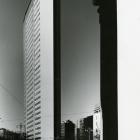Paolo Monti (1908-1982), "Milan. Pirelli Skyscraper", 1960-1965, gelatin silver bromide print, 24x30 cm, inv. c.085.08.04.tif
Paolo Monti's approach to the art of photography was gradual, developing his skills in line with the significant European artistic movements of the time, such as the Subjektive Fotografie, a German movement led by Otto Steinert. The years spent in Venice, where he moved from Milan for work, were a turning point in his career, both because of the effect lagoon life had upon him, and because of his meetings with other photographers. In the autumn of 1947, Monti founded “La Gondola”, a photographic club of which he was the main promoter and intellectual guide. This moment was the first step on a path that would lead him to become one of Italy's greatest photographers.
In 1953 he returned to Milan, abandoning his career in industrial management to dedicate himself entirely to photography. He would spend his entire career as a professional photographer, focusing on the urban changes of the post-war period (from the Qt8 neighbourhood in Milan to the new working class housing of San Siro and the Pirelli Skyscraper), documenting the Triennale and the Museums of the Sforza Castle and projects on commission, including editorial works such as the History of Italian Literature (1965), edited by Cecchi and Sapegno, for Garzanti and the History of Italian Art for Einaudi (1979). He was given an important public role under the direction of Andrea Emiliani in 1965 for the documentation of the historic and artistic heritage of the Emilian Apennines and the historic centre of Bologna, a mammoth undertaking. In parallel with his professional work he conducted a significant amount of experimental research, working on photograms, chemigrams and colour materials.








